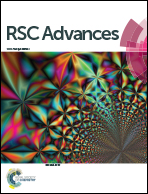Highly efficient dye-sensitized solar cells based on low concentration organic thiolate/disulfide redox couples†
Abstract
An imidazolium thiopropionate-based redox couple is introduced as an improved organic alternative to iodide/triiodide (I−/I3−) couples for dye-sensitized solar cells (DSSCs). The synthesized thiolate/disulfide (BMIT/BMIDT) redox couple shows negligible absorption in the visible spectral range, and higher redox potential (+0.72 V vs. NHE) compared with that of I−/I3−. With the optimized redox couple (such as 0.1 M/0.1 M)/dye N719 formulation, the fabricated DSSCs exhibit an average overall power conversion efficiency (PCE) of 6.8% and 8.1% under the simulated air mass 1.5 solar spectrum illumination at 100 and 50 mW cm−2, respectively. However, a higher concentration of the BMIT/BMIDT redox couple (such as 0.4 M/0.4 M) decreases the PCE of the devices, due to the desorption of dye molecules from the TiO2 photoelectrode surface.


 Please wait while we load your content...
Please wait while we load your content...